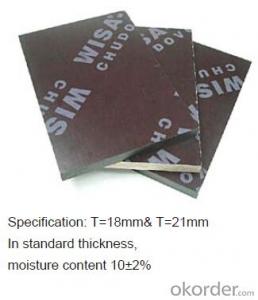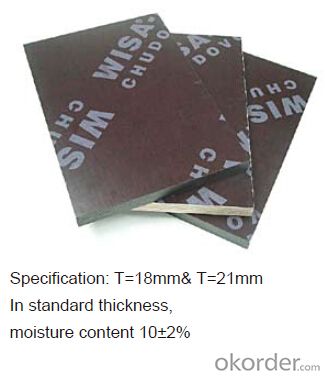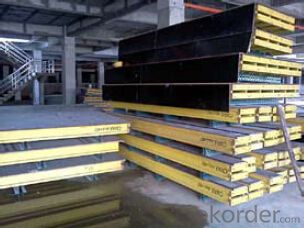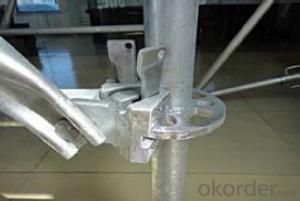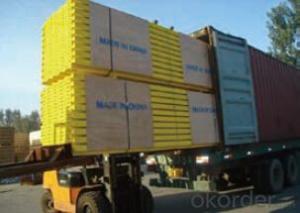Plywood Formwork System for Formwork and Scaffolding
- Loading Port:
- Tianjin
- Payment Terms:
- TT OR LC
- Min Order Qty:
- 50 g/m²
- Supply Capability:
- 1000 g/m²/month
OKorder Service Pledge
Quality Product, Order Online Tracking, Timely Delivery
OKorder Financial Service
Credit Rating, Credit Services, Credit Purchasing
You Might Also Like
Plywood --- make perfect concrete surface
WISA-Form Birch is a coated special plywood using in the formwork systems where high
requirements are set on the concrete surface and the times of reuses.
With CNBM timber beam & WISA plywood, the formwork is low weight but high load capacity, it is
widely used in construction.
Characteristics:
◆ Component with high standardization.
◆ Assembling in site, flexible application.
◆ Light weight, easy transportation and storage.

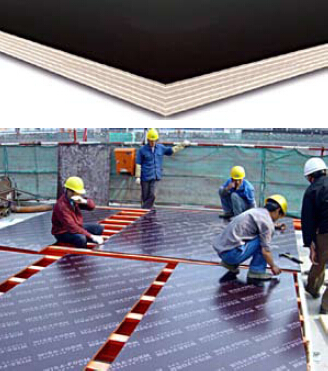
- Q: Can steel formwork be easily disassembled and removed after construction?
- Yes, steel formwork can be easily disassembled and removed after construction. Steel formwork systems are designed to be reusable and have a high level of flexibility in terms of assembly and disassembly. The components of steel formwork are typically lightweight and can be easily handled and moved by construction workers. Additionally, steel formwork systems often utilize adjustable clamps and brackets, allowing for quick and efficient disassembly. The ease of disassembly and removal of steel formwork not only saves time and labor costs but also allows for the formwork to be reused in future construction projects, making it a sustainable and cost-effective choice for construction projects.
- Q: Are there any specific maintenance requirements for steel formwork?
- Steel formwork has specific maintenance requirements that must be followed to ensure its optimal performance and durability. Cleaning the formwork after each use is crucial. This involves thoroughly removing any concrete residue and preventing the accumulation of corrosive agents. A mild detergent and water can be used for cleaning, followed by proper drying of all surfaces. Inspecting the formwork for any signs of damage or wear is also important. This includes checking for cracks, rust, or any other defects that could weaken the structure. Prompt repair or replacement of damaged components is necessary to maintain the formwork's integrity and safety. Proper storage and handling practices are essential for steel formwork maintenance. The formwork should be stored in a dry and well-ventilated area to prevent corrosion. Protection from moisture, extreme temperatures, and direct sunlight is necessary. When handling the formwork, abrasive materials or tools that could cause scratches or dents should be avoided. Regular lubrication of moving parts, such as hinges and locks, is recommended. This ensures smooth operation and prevents seizing or jamming. Using a suitable lubricant reduces friction and extends the life of these components. Lastly, it is advisable to follow the manufacturer's guidelines and recommendations for specific maintenance requirements of the steel formwork. These guidelines may include additional steps or precautions that are specific to the formwork system being used. By adhering to these maintenance requirements, steel formwork can be kept in excellent condition, allowing for efficient and safe construction practices.
- Q: Can steel formwork be used for both residential and industrial projects?
- Yes, steel formwork can be used for both residential and industrial projects. It offers durability, strength, and flexibility, making it suitable for various construction applications. Steel formwork is commonly used in both residential and industrial projects for its ability to withstand heavy loads, provide a smooth finish, and ensure accurate dimensions.
- Q: Can steel formwork be used for both horizontal and vertical concrete placement?
- Yes, steel formwork can be used for both horizontal and vertical concrete placement. Steel formwork is a versatile and durable solution for creating molds or frames that hold wet concrete in the desired shape until it sets and hardens. This type of formwork is commonly used in construction projects for various applications, including both horizontal and vertical concrete placement. Steel forms are strong enough to withstand the weight and pressure of the concrete, making them suitable for vertical applications such as walls, columns, and beams. Additionally, steel formwork can be easily adjusted or modified to accommodate different shapes and sizes, making it ideal for horizontal placements like slabs, floors, and pavement. Overall, steel formwork offers flexibility, strength, and stability, making it suitable for a wide range of concrete placement requirements.
- Q: What are the different types of formwork spacers used in steel formwork?
- There are several different types of formwork spacers used in steel formwork, including plastic spacers, metal spacers, and adjustable spacers. Plastic spacers are commonly used due to their lightweight nature, ease of installation, and durability. Metal spacers are often used in heavy-duty applications or where extra strength is required. Adjustable spacers are versatile and allow for flexibility in creating different formwork thicknesses.
- Q: How does steel formwork impact the overall project budgeting?
- Steel formwork can have a significant impact on the overall project budgeting. While the initial cost of steel formwork may be higher compared to other types of formwork, such as wood or plastic, it offers several advantages that can help offset the initial investment. Firstly, steel formwork is known for its durability and longevity. Unlike wood or plastic formwork, steel formwork can be reused multiple times without losing its structural integrity. This reusability factor reduces the need for frequent replacement or repair, thereby saving costs in the long run. Moreover, steel formwork provides a high-quality finish to concrete structures. The smooth and even finish achieved with steel formwork reduces the need for additional surface treatments or finishing work, resulting in cost savings. Additionally, steel formwork offers enhanced strength and stability, allowing for larger and more complex structures to be built. This can eliminate the need for additional support systems or reinforcements, which can be expensive and time-consuming. Furthermore, steel formwork is easy to assemble and dismantle, resulting in faster construction times. The quick turnaround time reduces labor costs and allows for earlier project completion, which can be particularly beneficial in time-sensitive projects. Lastly, steel formwork is resistant to weather conditions, such as moisture or extreme temperatures, which can negatively impact the formwork's effectiveness and lifespan. This resistance reduces the risk of formwork damage and replacement costs, thereby contributing to cost savings. Overall, while steel formwork may have a higher upfront cost, its durability, reusability, high-quality finish, strength, ease of use, and resistance to weather conditions can all contribute to cost savings in terms of reduced labor, material, and maintenance expenses. Therefore, steel formwork can have a positive impact on the overall project budgeting.
- Q: What are the different types of joints used in steel formwork?
- Steel formwork for construction projects commonly utilizes various types of joints to ensure stability and proper alignment of the system. 1. The most basic joint is the butt joint, which involves placing two formwork panels together with their edges abutting. Additional reinforcement, such as steel plates or angles, is often used to enhance strength and stability. 2. Corner joints, as the name suggests, connect formwork panels at corners. These joints are usually reinforced with steel angles or brackets to ensure proper alignment and support. 3. T-joints are used when formwork panels intersect at a perpendicular angle. This joint involves connecting three panels together, with one positioned perpendicular to the other two. 4. L-joints are similar to T-joints but are used when panels intersect at a 90-degree angle. This joint involves connecting two panels together, with one positioned perpendicular to the other. 5. Lap joints are used to connect long formwork panels, creating a continuous surface. This joint involves overlapping the edges of two panels and securing them with bolts or clamps. 6. Hinged joints are employed when adjustable or movable formwork panels are required. This joint allows for flexibility in placement and can be locked in different positions to accommodate various shapes and sizes. It is essential to consider the specific requirements of the construction project, including the desired formwork system and structural design, when selecting the appropriate joint. This selection plays a crucial role in ensuring the overall stability and strength of the formwork system.
- Q: How does steel formwork affect the overall vibration resistance of the structure?
- A structure can greatly improve its vibration resistance through the utilization of steel formwork. Steel, as a formwork material, offers several advantages that contribute to enhanced structural stability and reduced vibrations. To begin with, steel formwork is renowned for its exceptional strength and rigidity. It provides a sturdy framework that can withstand the dynamic forces and loads experienced by a structure throughout its lifespan. This increased strength aids in the minimization of potential vibrations caused by external factors such as wind, earthquakes, or nearby heavy machinery operations. Additionally, steel formwork enables a precise and accurate construction process, ensuring a tight fit and proper alignment of structural elements. This precise assembly reduces the presence of any gaps or unevenness, which can amplify vibrations. By minimizing these irregularities, the overall vibration resistance of the structure is improved. Moreover, steel formwork exhibits excellent dimensional stability, meaning it remains unchanged in size, shape, or form under varying environmental conditions. This stability guarantees that the structure maintains its integrity and avoids significant deformations that could lead to increased vibrations. Furthermore, steel formwork possesses remarkable resistance to corrosion and deterioration, ensuring its long-term durability. This resistance prevents any weakening of the structure over time, which is crucial for maintaining its vibration resistance. Furthermore, steel formwork offers a higher load-carrying capacity compared to other formwork materials. This increased capability allows for the construction of more robust and resilient structures that can withstand higher dynamic loads without experiencing excessive vibrations. In conclusion, the utilization of steel formwork greatly enhances the overall vibration resistance of a structure by providing strength, rigidity, precision, dimensional stability, corrosion resistance, and increased load-carrying capacity. By incorporating these characteristics, steel formwork helps to minimize vibrations and ensures the structural integrity and safety of the building.
- Q: How does steel formwork handle different concrete surface slip resistance?
- Steel formwork is a versatile and strong material that is commonly used in construction projects to shape and support concrete during the curing process. When it comes to handling different concrete surface slip resistance, steel formwork offers several advantages. Firstly, steel formwork provides a smooth and even surface for pouring concrete, which helps to minimize variations in slip resistance. Unlike other materials such as wood, steel does not warp or deform, ensuring consistent contact between the formwork and the concrete. This uniformity in contact helps to create a more consistent concrete surface, reducing the chances of uneven slip resistance. Additionally, steel formwork allows for the use of various surface treatments and coatings that can enhance slip resistance. For instance, anti-slip coatings or aggregates can be added to the formwork surface before pouring the concrete, creating a textured surface that improves traction. These treatments can be customized to meet specific slip resistance requirements, allowing for flexibility in design. Moreover, steel formwork is highly durable and resistant to wear and tear. This durability ensures that the formwork maintains its structural integrity throughout the concrete pouring process, minimizing the chances of surface irregularities that could affect slip resistance. Furthermore, steel formwork can be easily cleaned and maintained, ensuring that any contaminants or debris that could affect slip resistance are promptly addressed. In summary, steel formwork is able to handle different concrete surface slip resistance by providing a smooth and consistent surface, allowing for customization through various surface treatments, and maintaining durability to prevent surface irregularities. Its strength and versatility make steel formwork a reliable choice for construction projects where slip resistance is a concern.
- Q: Can steel formwork be custom-made?
- Indeed, the option of customizing steel formwork exists. Steel, being an adaptable material, can be effortlessly molded and joined together through welding to produce formwork tailored to suit specific project demands. In situations where conventional formwork systems may prove inadequate due to distinctive design components or intricate geometries, the utilization of custom-made steel formwork is frequently favored in construction endeavors. The customization of steel formwork allows construction firms to ensure a perfect fit, thereby facilitating efficient and precise pouring of concrete, minimizing waste, and preserving time and financial resources. Moreover, the durability and reusability of custom-made steel formwork offer enduring advantages for numerous construction projects in the long run.
Send your message to us
Plywood Formwork System for Formwork and Scaffolding
- Loading Port:
- Tianjin
- Payment Terms:
- TT OR LC
- Min Order Qty:
- 50 g/m²
- Supply Capability:
- 1000 g/m²/month
OKorder Service Pledge
Quality Product, Order Online Tracking, Timely Delivery
OKorder Financial Service
Credit Rating, Credit Services, Credit Purchasing
Similar products
Hot products
Hot Searches
Related keywords
